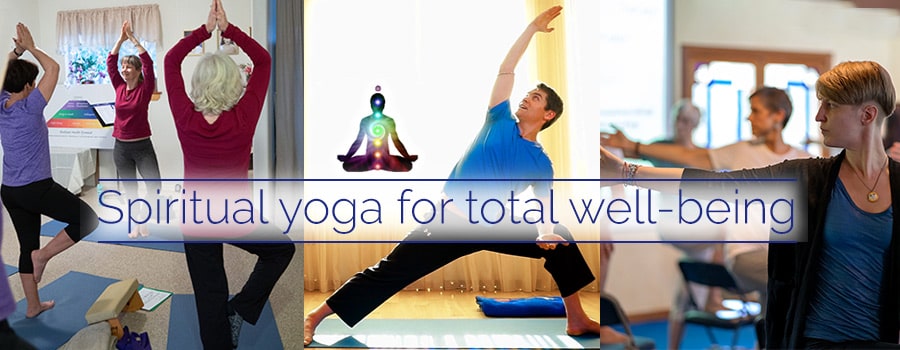Teaching Yoga in a Health Care Setting
In 1983, when I first decided to go to nursing school, I thought I would get training in an occupation that would be service-oriented, and then I would find a way to integrate spiritual teachings into my work.
Over the years I have worked in many traditional settings: hospital, health department, home health, and hospice. I have attempted to use yoga — including meditation, affirmation, attunement, right attitude, and prayer — as a tool in my personal practice as I try to be a channel of healing and blessing to patients and coworkers.
Rarely, however, was there an occasion when I felt permission to openly share yogic teachings with patients. Times have changed. Now medical providers often recognize yoga and meditation as self-care approaches to many common health issues.
Since taking Ananda Yoga Teacher Training in Spring 2003, I have found an opportunity to be able to offer the patients whom I serve something more than shots and pills for their health care needs.
Research on Rural Depression
For the last three years I have worked as a Registered Nurse at Sierra Family Medical Clinic (SFMC). This clinic was founded by Dr. Peter Van Houten, M.D., who later gave the clinic to the larger community surrounding Ananda Village, where he is a resident.
Dr. Van Houten is still the medical director, but the clinic is now a non-profit rural health care clinic governed by a board of directors made up of volunteers from the surrounding area. Since rates of depression are high in rural areas, SFMC has been included in a three-year research project funded by The University of California at Davis to study depression and the effects of integrating behavioral health care services into rural health care clinics in Northern California.
Grant money from this study has enabled the clinic to hire a Licensed Clinical Social Worker, Jennifer, who specializes in behavioral modification and cognitive therapy. As part of the study, we screen all our patients for depression and anxiety via a mental status questionnaire.
Often the screening shows that the patient could benefit from counseling to help him or her deal with problems such as depression and anxiety, or the stress of living with a chronic disease. In such cases our medical providers introduce the patient to Jennifer and set up visits with her. During her counseling sessions, Jennifer recommends practical interventions to help change harmful behaviors and ways of thinking.
She asks patients to practice making these changes at home. The “homework” can be as simple as “Go out in the fresh air and take a walk for 30 minutes each day,” or “Read an inspirational book for 15 minutes a day.” On the other hand, it also can be as difficult as exploring alternative behaviors to replace a habit of smoking, or setting boundaries in an abusive relationship.
As part of her individual counseling, Jennifer also talks to people about relaxation techniques and, when appropriate, even leads them through a progressive relaxation exercise. Many patients greatly appreciate this service, as now they don’t have to go to a separate facility for counseling. They also have the assurance of continuity in their care because all the providers (medical and behavioral) are in close communication with each other regarding the treatment plan.
It has been a wonderful way to offer a more holistic approach to health issues.
Ananda Yoga® to the Rescue
Recently Jennifer and I began working together by offering these same patients a weekly “relaxation training” group. Simply bringing together people who have similar difficulties can be therapeutic in that the group provides support and social interaction.
Beyond that, however, we talk about the benefits of affirmation, visualization, and the body/mind connection that makes stretching, body awareness, and posture useful in achieving stress reduction and relaxation.
How do these benefits come about? Often people with chronic diseases become committed to negative thought patterns that contribute to a self-perpetuating cycle of stress and anxiety. For example, they may feel a sense of sadness and despair about losing their former healthy state. Or they may feel helplessness and dependence on doctors to provide effective medications for relief of discomfort. Or they may experience anxiety as they worry about the disease’s progression and how they will cope with decreased ability to function.
These negative emotions usually lead to muscular tension and increased pain, as well as mental tension and stress. Using affirmations and visualizations with gentle yoga stretches is a powerful combination to counteract both physical and mental aspects of the problem. We can help the mind be more uplifted and receptive by assuming a posture that lengthens the spine, as is natural when we feel good.
Gently stretching muscles sends a message of relaxation and well-being to the brain, creating the perfect opportunity to practice interjecting a positive perspective into depressed thought habits through affirmation and visualization. In this way, if we can experience a feeling of well-being, harmony, and peace — even briefly — it gives us something to come back to and expand upon. Just a moment spent recognizing our innate inner joy can be the foundation for building a renewed sense of strength and ability to find happiness despite a host of outer difficulties.
Ananda Yoga provides all these elements, so it fits beautifully in this setting as a tool for behavior modification and relaxation training.
The Group Process
At the beginning of our group time, I take each patient’s blood pressure and pulse, and have them rate their anxiety or mood on a scale of 1 to 10 for comparison afterward. Then I lead a routine of gentle yoga postures with affirmations, incorporating breathing exercises into the poses. We end with a visualization during deep relaxation.
I usually go through all the body parts, giving special emphasis to any parts with which I am aware that someone has difficulty. I have them visualize conscious healing light filling the body on the inhalation; on the exhalation, they visualize tension, fear, disease, and pain melting into the light. We visualize the internal organs radiating with light, serving the body in the best possible way. We see the heart pumping, not just blood, but healing light to nourish every cell with light. We flood the brain with light, dissolving all worries about the future, all regrets from the past, so we can fully experience living this moment in perfect light and joy.
Last week I focused the visualization on peace and calmness, seeing the body floating on a lake of peace, being gently caressed and bathed in the soothing waters of peace. Then I read “On Spreading Ripples of Peace” from Paramhansa Yogananda’s Metaphysical Meditations. [See Nine Deep Relaxations and Visualizations for some excellent visualizations that you could use. —Editor]
By the end of these practices, we usually see an elevation in a patient’s mood as well as a decrease in blood pressure and pulse readings. Interestingly, one participant who usually has very low blood pressure either stays the same or has a mild elevation in her reading, which probably represents a normalization of pressure for her.
To end our time together, I ask everyone to choose an affirmation that we used during the class. I write each patient’s choice on a note card so he or she can take it home and practice during the week. Because of this special setting in which I teach, I have to modify some of the asana affirmations to take out any religious reference. For example, in Tadasana I use, “I stand ready to make positive changes in my life,” instead of, “I stand ready to obey Thy least command.”
One of the favorites has been an affirmation that needs no modification, the one for Savasana: “Bones, muscles, movement, I surrender now. Anxiety, elation and depression, churning thoughts, all these I give into the hands of peace.” In fact, when one patient who had Lyme Disease came to the clinic a few days later for a painful injection, she asked me to repeat this affirmation with her while she waited for the anesthetic that we give prior to the shot to take effect. She found it helpful in dealing with the uncomfortable procedure.
One day, the group included a woman who reported a long list of medical problems to me, and then admitted that the problem currently bothering her most was headaches. So I changed my planned routine and brought out the yoga therapy book that Gyandev McCord and Dr. Van Houten recently wrote: Yoga Therapy for Headache Relief.
Because the patient stated that she also had a history of a bulging lumbar disc, we modified the routine recommended in the book to keep her back in a neutral position. She was delighted to be offered something besides medications to help deal with her pain. In fact, after the second week she left telling everyone how much better she felt. Since this patient usually found it difficult to report anything positive about her life, and often resisted the recommended interventions, exclaiming that she felt better after our group session was a definitely a step forward.
Addressing Chronic Back Pain
Recently we have started offering individualized yoga sessions for patients with chronic back pain. Studies have shown that treating depression in pain patients can help alleviate not only their mental suffering, but their physical suffering as well.
After studying Back Care Basics and after taking the Level 2 Ananda Yoga Teacher Training classes Adapting Asanas for Physical Limitations [No longer offered in the same form — Editor] and Therapeutic Yoga, I developed a list of postures that are safe and helpful for this patient population.
We start very cautiously, with careful attention to individual response, and I modify the list to fit the limitations of specific back problems. Something as subtle as pelvic tilts or cat/cow stretch can be beneficial in not only stretching and strengthening muscles that support the low back, but also enhancing awareness of posture and alignment.
Ananda Yoga® affirmations and visualizations provide these patients with something more than what they can get from traditional physical therapy. The mental and spiritual aspects of a yogic approach add a valuable dimension that goes beyond mechanical exercises. People in pain often focus on their discomfort to the point where all they can see around them is unhappiness. When we do supine hamstring stretches with a strap, I use it as a modification of Janushirasana so we affirm “Left and right and all around, life’s harmonies are mine.”
This gives me the opportunity to mention how, when we approach life with positive expectations, we are more likely to find those positive qualities reflected back to us.
Of course, it takes an extra effort of will power to find joy or harmony in spite of an uncomfortable body. So if it is appropriate, we do a simple version of Virabhadrasana to strengthen the muscles of the legs, buttocks, and abdomen that support the spine. The affirmation for this pose speaks of power and inner strength with joy. For my particular setting, I have modified it to, “I joyfully manifest the power of my inner strength.”
Patients have responded enthusiastically to these private sessions. Now my challenge is to inspire these folks to practice the exercises at home and create new habits in the way they sit, stand, and go about their activities of daily living. A woman who works as a bus driver told me that, after our yoga session, she went home feeling great and had the best night’s sleep she’d experienced in years — and she woke up in significantly less pain. Since she complained that her pain was worse in the mornings, we had suggested changing her sleep position to give her back better support.
One week after our class, however, she admitted to suffering with her usual back pain again. Her difficulty (as with most people) has been in finding time to keep practicing the exercises at home.
I am currently working on making the list of home exercises short enough to do in just ten minutes a day. Also, I want to provide more ideas how to incorporate stretching and affirmation into daily activities. For the bus driver, I recommended doing pelvic tilts as she is sitting at a bus stop. She worried that passengers might think she is “squirming in her seat,” so I am waiting to hear back from her how this worked. These classes are still a work in progress, but I find that the more I share these teachings with others, the more I am helping myself to deepen my own application of yogic principles to every aspect of my life.
Expanding the Dream
I’ve always believed that traditional medicine has its place in helping people deal with physical disease, but that attending to one’s consciousness, as in the practice of yoga, is even more basic to finding true health in body, mind, and spirit. So using Ananda Yoga to help patients cope with stress, depression, and anxiety — and now back problems, too — in a family practice clinic is providing, at long last, the integration of two worlds that I hoped for when I first began my journey as a nurse. Teaching opportunities like this one will surely become more available as time passes and we see the dawning of a more enlightened medical community.
Related Articles
Related Courses
All authors are graduates of Ananda Yoga Teacher Training.





















